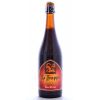Bierbrouwerij De Koningshoeven - La Trappe Bockbier
-
ABV:
7% -
Serving Temperature:
50–59° F -
Suggested Glassware:
Dimpled Mug, Tulip, or Chalice
Without giving away the ending, we’ll say this: this is unlike any bock we’ve tasted before.
We poured tastes of this into Pinot-appropriate stemware, producing just a great-looking glass: deep caramel-brown tones, dark cola, with really nicely rendered foam. Big headed, small bubbled, and lots of impressive retention and lacing that was almost like icing. One could pretty much guarantee from appearance that, at the least, this would be interesting.
Seriously: great looking beer. Magical foam.
The aroma’s just as appealing: plenty of rich caramel and brown sugar and cola-like notes, but tempered well by spices presumably coming from a Belgian yeast strain. Nice red fruit, pepper and clove, even a bit of vanilla in there. It makes sense, given it’s “the world’s only Trappist bock beer”—but there’s something super appealing about matching bock qualities to yeast characteristics we’d normally expect from a dubbel. The balance of bocks can be a bit precarious: dense caramel, dried dark fruits, and toffee from those generous middle-of-the-spectrum malts, with any lingering sweetness left over from the ferment often sticking out like a sore thumb. We’ve had great bocks, and we’ve had terrible bocks. With only that nudge of lean alcohol and a mild bitterness to keep things on point, things can head south.
Here? The Belgian yeast qualities work great. Those caramelized sugars and dried fruits are still front and center here, but that pepper and clove let those elements play out even more vividly than they might be able to with a lager strain. And the Belgian yeast character is just generally super appealing: it almost feels a bit like a German hefeweizen strain, leading with clove and (while not necessarily hitting banana notes) set alongside sweet, soft fruitiness. If we take a stylistic step back for a moment, ignoring the label, this is basically built much like a weizenbock, with that generous middle-malt core met by a clove-forward yeast character.
And, let’s be honest: we really dig weizenbocks. There so aren’t enough weizenbocks.
Koningshoeven’s La Trappe Bockbier is likely to be unlike any bock you’ve encountered so far. And we think it’s a pretty fantastic experience. The pour’s beautiful, the aroma is potent and progressively more generous as this warms, and the taste is like what would happen if a bock, weizenbock, and Belgian dubbel walked into a bar. No joke. The carbonation keeps a generously developed core feeling light on the palate, and everything there just feels perfect. The bock qualities do lead, with the Belgian yeast qualities tucked in behind the more subtle spicy hop character when this is served straight from the fridge. But this? No ordinary bock.
The brewery gives this a best-by date about three years out. We found it exceptional fresh, with an ideal balance between those core malts and the bitterness of the yeast quality. But a bit of caramelized oxidation and the likely influx of sherry-like aspects with some time to age seem like they would fit in just fine. La Trappe Bockbier is bottle conditioned to boot. So we wouldn’t hesitate to lay down some of these for a year or so. The caramel plus red fruitiness here seems a likely fit to roasted and grilled pork, or a dessert like caramel torte or apple pie.
The Bierbrouwerij de Koningshoeven reminds us of the Eddie Izzard line regarding Europe being: “where the history comes from.” The brewery certainly has a well-earned pedigree in addition to making some fantastic beers along the way. The Cistercian monastery that houses the Trappist brewing operations was originally founded in the small town of Berkel-Enschot back in the 1880s, in response to the dismal situation French monasteries were facing at the time. A monk, Sebastian Wyart, was sent to stake out a distant place of refuge, and he landed in Berkel-Enschot: “an area of open heath with several small farmhouses and a sheepfold.”
Local parlance for the area was Koningshoeven, meaning “The King’s Farmhouses,” having been previously owned by King William II. We’re still not entirely sure what a sheepfold is.
A problem though: even after converting said sheepfold into a makeshift monastery in 1881, the surrounding land was pretty iffy for cultivating crops. Saint Benedict, the key founder of Western monasticism, wrote that, “When they live by the labor of their hands, then they are really monks.” By 1884 it had become apparent that, try as they might with farms and cattle, the labor of their hands could probably be put to better application. So they started brewing.
Today, the La Trappe beer brewed in Koningshoeven is still brewed in a Trappist monastery “under the supervision and responsibility of the monks”—the key aspect of being able to be considered a Trappist brewery. La Trappe was the Netherlands’ first Trappist beer. Even 130 years later, the brewery remains the most important source of livelihood for the monastery.
There are only ten Trappist breweries in the entire world that can call themselves “Authentic Trappist Product.” And the fermented works of the Cistercian Abbey of Onze Lieve Vrouw van Koningshoeven have been in production for way past a century. Maybe Europe really is where the history comes from. This month, we’re excited to present arguably our favorite of the La Trappe line: their Bockbier, which happens to be the only Trappist bock in existence. This is the first time it’s been released in 750ml bottles in about 8 years, and we’ve snagged the majority of the release for our members, with the remainder making its way into very limited distribution in only a handful of states.

Unmatched Variety by style, brewery & country
Choose from Five different Beer Clubs offering unmatched variety by brewery,
country of origin, and beer style to suit your specific tastes.


